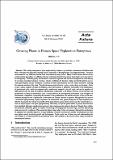Por favor, use este identificador para citar o enlazar a este item:
http://hdl.handle.net/10261/209675COMPARTIR / EXPORTAR:
 SHARE SHARE
 CORE
BASE CORE
BASE
|
|
| Visualizar otros formatos: MARC | Dublin Core | RDF | ORE | MODS | METS | DIDL | DATACITE | |

| Título: | Growing plants in human space exploration enterprises |
Autor: | Medina, F. Javier CSIC ORCID CVN | Fecha de publicación: | 2020 | Editor: | European Space Agency | Citación: | Acta Futura 12:151-163 (2020) | Resumen: | The coming enterprises of space exploration by humans, e.g. the future colonization of the Moon and Mars, will require the utilization of plants as key components of Bioregenerative Life Support Systems. The space environment is very different from the Earth environment in many factors. Many of these adverse factors can be counteracted in spaceships, or in Martian or Lunar settlements, but the living beings must adapt to grow and survive in microgravity. The Earth gravity has remained constant in magnitude and direction throughout the entire history of our planet, including biological evolution. Gravity establishes the direction of plant growth through the process called gravitropism and this orientation is essential for the normal function of roots, stems and leaves, assuring the adequate nutrition of the plant. The phytohormone auxin is known to play a main role in gravitropism. Auxin is also a major regulator of plant development, since this hormone is ultimately responsible of the maintenance of meristematic cells, which are totipotent cells, continuously engaged in the cell cycle, and are the suppliers of differentiated cells for plant development. Meristematic competence is the balance between cell growth and cell proliferation occurring in meristematic cells. A major effect of the microgravity environment is the disruption of meristematic competence, comprising the increase of the proliferation rate and the decrease of the growth rate,estimated through the rate of production of ribosomes, the cellular factories of proteins. Microgravity also induces a noticeable reprogramming of gene expression. In meristematic cells, genes driving the cell cycle regulation are affected. In general, the systems responsible of the plant defense against abiotic stresses and the energy/redox systems are major targets of the gene reprogramming. Noticeably, no specific genes related to gravity alteration have been identified, although a significant proportion of altered genes encode unknown functions. Despite these cellular and molecular alterations, plants are capable of surviving, developing until the adult stage, and even reproducing under microgravity conditions. This means that plants indeed adapt to this environment, although the mechanisms of adaptation are currently unknown. A major challenge of current research is to identify environmental cues that may replace gravity in driving growth and development. Light can be one of these cues and understanding the role of light, as a countermeasure for gravitational stress, will contribute to the success of the culture of plants in extraterrestrial habitats. | Descripción: | 14 p.-4 fig. | Versión del editor: | https://doi.org/10.5281/zenodo.3747367 | URI: | http://hdl.handle.net/10261/209675 | DOI: | 10.5281/zenodo.3747367 | E-ISSN: | 2309-1940 |
| Aparece en las colecciones: | (CIB) Artículos |
Ficheros en este ítem:
| Fichero | Descripción | Tamaño | Formato | |
|---|---|---|---|---|
| AF_Medina_2020.151.pdf | Artículo principal | 295,29 kB | Adobe PDF |  Visualizar/Abrir |
CORE Recommender
Page view(s)
286
checked on 23-abr-2024
Download(s)
169
checked on 23-abr-2024
Google ScholarTM
Check
Altmetric
Altmetric
Este item está licenciado bajo una Licencia Creative Commons

